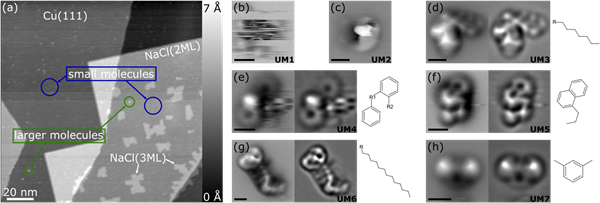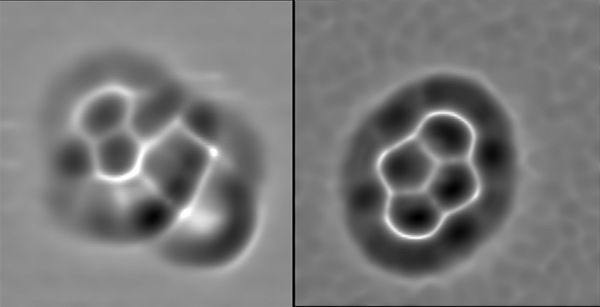Carbonaceous meteorites are widely thought to have been an essential source of organic compounds for the early Earth; some scientists even believe these organics were crucial for the origins of life on Earth. Recent advances in atomic force microscopy (AFM) have allowed scientists to visualise individual molecules so that they can see the individual atoms and bonds in them. For the first time, individual organic molecules from carbonaceous meteorites have been visualised using AFM, opening a new window into understanding the structure of the Solar System's earliest organic compounds at atomic resolution.

Carbonaceous meteorites are widely thought to have been an important source of organic compounds for the early Earth; some scientists even believe these organics were crucial for the origins of life on Earth.
During the 20th century, scientists developed numerous methods to understand chemical composition at the molecular level, including mass spectrometry (MS). MS now allows for indirect determination of molecular composition, sometimes to the point of unambiguously being able to determine the structure of the molecules present in a sample.
Recent advances in atomic force microscopy (AFM) have allowed scientists to visualise individual molecules so that they can see the individual atoms and bonds in them. Now for the first time, a team led by IBM Research in Switzerland, including Specially Appointed Professor, Henderson James Cleaves II from the Earth-Life Science Institute at Tokyo Institute of Technology, and researchers from NASA, the Universidade de Santiago de Compostela in Spain, and Normandie University, Aix-Marseille Universite, and the Institut Universitaire de France in France have now for the first time managed to directly image individual organic molecules from the Murchison carbonaceous meteorite using AFM. This opens a new window into understanding the structure of the Solar System's earliest organic compounds at atomic resolution.

The molecules the team were able to visualise directly proved to be complex polycyclic aromatic hydrocarbons and aliphatic chains, which were already suspected to be present in these meteorites using previously developed techniques, but this work now provides direct proof that those molecules are present.
This work provides a proof of principle that AFM can be used to image and identify individual organic molecules from meteorites and provides a new method for extracting and preparing meteorite samples for their investigation by AFM has been developed.
| Journal | Meteoritics & Planetary Science |
| Tile of the paper | Visualisation and identification of single meteoritic organic molecules by atomic force microscopy |
| Authors | Katharina Kaiser 1, Fabian Schulz1, Julien F. Maillard2, Felix Hermann1, Iago Pozo3, Diego Peña3, H. James Cleaves II4,5, Aaron S. Burton6, Gregoire Danger7,8,9, Carlos Afonso2, Scott Sandford10, Leo Gross1* |
| Affiliations | 1. IBM Research—Zurich, Rüschlikon, 8003 Switzerland 2. Normandie Univ, COBRA, UMR 6014 et FR 3038 Univ Rouen, INSA Rouen, CNRS IRCOF, 1 Rue Tesnière, Mont-Saint-Aignan Cedex, 76821 France 3. Departamento de Química Orgánica, Centro Singular de Investigación en Quımíca Biolóxica e Materiais Moleculares (CiQUS), Universidade de Santiago de Compostela, Santiago de Compostela, 15782 Spain 4. Earth-Life Science Institute, Tokyo Institute of Technology, 2-12-1-IE-1 Ookayama, Meguro-ku, Tokyo 152‑8550 Japan 5. Blue Marble Space Institute for Science, 1001 4th Ave, Suite 3201, Seattle, Washington, 98154, USA 6. Astromaterials Research and Exploration Science Division, NASA Johnson Space Center, MS XI-3, Houston, Texas, 77058 USA 7. Laboratoire de Physique des Interactions Ioniques et Moléculaires (PIIM), CNRS, Aix-Marseille Université, Marseille, France 8. CNRS, CNES, LAM, Aix-Marseille Université, Marseille, France 9. Institut Universitaire de France, Paris, France 10. Space Science Division, NASA Ames Research Center, MS 245-6, Moffett Field, California 94035 USA |
| DOI | 10.1111/maps.13784 |
| Online published date | 1 February 2022 |
